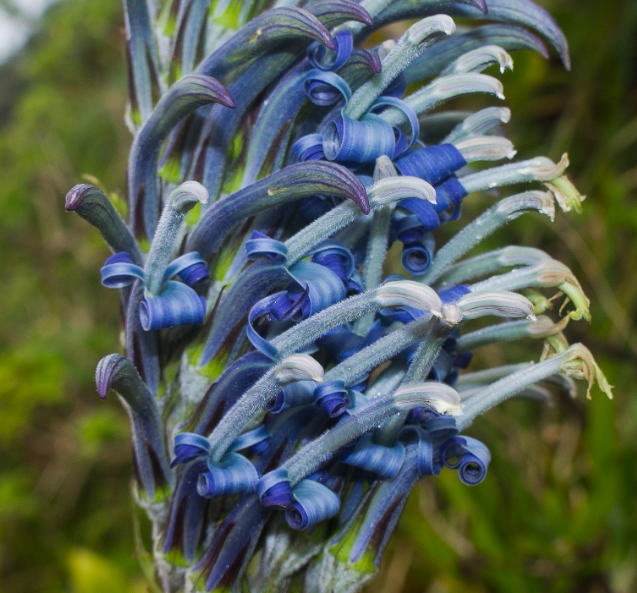04/24/23 – COLLABORATING TO KEEP A RARE NATIVE HAWAIIAN PLANT WILD
Posted on Apr 24, 2023 in Forestry & Wildlife, Main, News Releases, slider
| JOSH GREEN, M.D. GOVERNOR |
DAWN CHANG |
For Immediate Release: April 24, 2023
COLLABORATING TO KEEP A RARE NATIVE HAWAIIAN PLANT WILD
Helping Lobelia oahuensis Recover
To view video please click on photo or view at this link: https://vimeo.com/817472252
(HONOLULU) – The windswept ridges of the Waiʻanae range on Oʻahu’s west side are home to some of the rarest native plant species in Hawaiʻi. Earlier this month, staff from the Plant Extinction Prevention Program (PEPP), Laukahi, and the DLNR Division of Forestry and Wildlife (DOFAW) visited the area as part of a collaborative project to restore Lobelia oahuensis to the wild. It’s a species endemic to the island.
Listed as endangered in 1994, the population estimate at that time was 100 to 200 plants. At the recovery project’s outset in 2019, those numbers dropped to fewer than 20 individual plants. With a grant from the U.S. Fish and Wildlife Service – DOFAW/PEPP staff and partners set an ambitious course to preserve the species.
The project’s goal is to grow and transplant 2,500 individuals in five locations on Oʻahu, and they’re well on their way. “We’re currently at around 2,300 plants, so we’ve nearly hit our goal,” said DOFAW Botanist Susan Ching. “Some sites are doing better than others, but we’re learning a lot about the species and what it needs to thrive. So far, so good.”
Laukahi, a network of agencies and individuals partnering to protect Hawai‘i’s rare plant species, and the Lyon Arboretum Hawaiian Rare Plant Program at the University of Hawai‘i played key roles in getting the project off the ground.
“Our role is to coordinate projects and assessments that summarize plant conservation work across the state,” said Kimberly Shay, Laukahi Network Coordinator. “Communicating that information with partners identifies the gaps in our work and helps guide their actions to conserve as many plants as possible.”
At the project’s outset, seeds were collected from the remaining wild “founder” plants and deposited at Lyon Arboretum for storage and propagation purposes. Banking the seeds at Lyon’s Seed Conservation Lab served as an insurance policy for the plants while the micropropagation and greenhouse facilities supported growing plants for restoration efforts.
The process, from germination to planting for L. oahuensis takes six to seven months, but that’s only one piece of the puzzle. Another focus is protecting the habitats at the wild planting locations from various threats. Threat-control projects include fencing to protect the plants from feral pigs, using rat- and slug-control measures, and weeding invasive grasses and plant species.
Another threat to rare plants in our forests, especially on Oʻahu, is foot traffic. With the largest population and highest visitor numbers in the state, this means greater human impact rates and one more hurdle for rare plants.
“In recent years we’ve seen growing interest in people wanting to view Hawai‘i’s plants and explore, which is great,” explained Ching. “For our extremely rare plants however, large visitation numbers are detrimental to their populations. We want to stress to be aware of your surroundings. Enjoy the beauty, but also respect the vegetation and habitat of our forests.”
Simple actions, like staying on trails, leaving the forest as you found it, and spreading the word to other hikers to act as good land stewards can help contribute to healthier forests and project success for L. oahuensis.
“What makes these efforts successful is the people in the network,” said Shay. “The plants are their agenda.”
Ching also appreciates the working group. “There is a small core group across the state and 100 percent of our efforts are going into trying to save the last of the last, the rarest of the rare plant species. We hope that feeling comes through to the community that we’re here to work for the plants.”
# # #
RESOURCES
(All images courtesy: DLNR)
Video – PEPP Lobelia oahuensis (April 5, 2023):
Photographs – PEPP West Oʻahu (April 5, 2023):
https://www.dropbox.com/sh/t8pkfb5isou344e/AAB-JHEbXEH-5s26zQ6OTsWma?dl=0
Rare Plant Code of Conduct – Guidelines for Responsible Viewing: https://dlnr.hawaii.gov/ecosystems/files/2016/08/HRPRG_RarePlantCode_Final_Hawaii.pdf
Media Contact:
Ryan Aguilar
Communications Specialist
Hawai‘i Dept. of Land and Natural Resources


